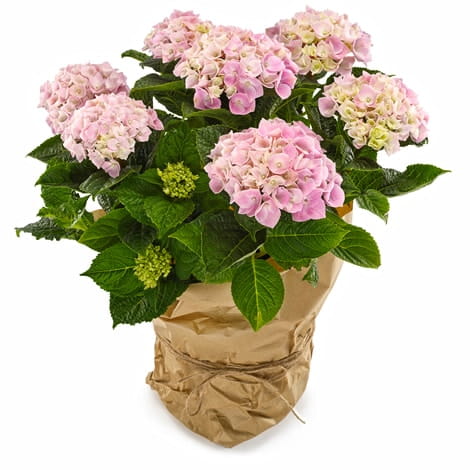Author: Peter Karper
Origin of the name
Hydrangeas were named in honour of Hortense de Beauharnais, who was born in France in 1807 as the daughter of Napoléon Bonaparte and Joséphine de Beauharnais. Marie-Louise's comrade was a very talented gardener and loved beautiful flowers. Her name is therefore a tribute to her talent.
Characteristics of hydrangeas
Would you like to know the characteristics of hydrangeas? Here we have listed some of the characteristics of hydrangeas:
- Colours: They bloom in different colours such as white, rosé, pink, blue and purple.
- Genus: Hydrangeas belong to the rue plant family.
- Leaves: The petals are always arranged in the form of cups.
- Flowers: Depending on the hydrangea species, the flower shape can be recognised as spherical, cupped or hemispherical.
- Care: Pruning should be done carefully and in spring, hydrangeas are hardy and need plenty of water and sun.
Flowering calendar for hydrangeas
Here is a flowering calendar that shows you when which hydrangea species are in bloom:
- June: Farmer's hydrangea (Hydrangea macrophylla), panicle hydrangea (Hydrangea paniculata)
- July: Snowball hydrangea (Hydrangea arborescens), climbing hydrangea (Hydrangea petiolaris)
- August: Farm hydrangeas, panicle hydrangeas
- September: Late varieties of panicle hydrangeas

Message and meaning of hydrangeas
The hydrangea is a wonderful flower that can have many different meanings. It can symbolise love and affection, but also good luck and a positive sign of good wishes. For many people, the hydrangea is a symbol of friendship and trust.
However, it can also be understood as a gesture of respect. No matter what the meaning of the flower is for you, hydrangeas give you a reason to be happy and beautify your home. The greeting card is also important when giving such wonderful flowers as gifts. With your very personal message, you can express what you want to convey with your flowers.
Hydrangea care guide
In general, the same care instructions apply to hydrangeas as to most other flowers. That's why you should definitely read our flower blog post on hydrangea care. The tips and tricks in this guide will help you.
Occasions for sending hydrangeas
As they are a beautiful and popular flower, there are numerous occasions to send them. For example, it is always nice to give someone a bouquet of hydrangeas to wish them a happy birthday.
You can also send a beautiful bouquet of flowers to friends and family on other occasions, such as an anniversary, to express your love and appreciation. Of course, these flowers also cut a fine figure as a romantic gift.
They also make a great gift to congratulate someone after a hospitalisation or the birth of a child. In short, a bouquet of hydrangeas is the ideal gift to make someone happy in any situation. Hydrangeas also go well with anniversaries, birthdays, weddings, romantic occasions and all kinds of special occasions.
Card text templates to send
Card text sayings that you can use when sending hydrangeas, simply copy and paste into the card text when sending.
Version 1
Dear [name],
I would like to send you a lovely greeting and brighten up your day! The bright colours of the hydrangeas remind me of you and your cheerful nature. I wish you all the best and lots of joy!
Best regards,
[Name]
Version 2
Dear [name],
I'm thinking of you right now and would like to send you my best wishes! I would like to make you happy with this card, just like the beautiful hydrangeaflowers. I wish you good luck, success and all the best!
Best regards,
[Name]
Flowering time
These magnificent flowers are a great eye-catcher in any garden. They bloom from June to August and some varieties even a little longer. It's best to plant them in a sunny spot, but keep them in partial shade to preserve the colour of their flowers for a long time. As hydrangeas are relatively hardy, it is also possible to plant them in pots and bring them indoors if you want year-round splendour in the garden or at home.
FAQs about hydrangeas
1. how do I plant hydrangeas correctly?
When plantinghydrangeas, it is important to choose the right location. Hydrangeas prefer a semi-shady location and an acidic soil with a low pH value. Make sure the plant gets enough water and use special hydrangea fertiliser.
2 How often should I fertilise my hydrangeas?
Fertilise your hydrangeas in spring and summer to ensure lush flowering. It is best to use an organic fertiliser for this.
3. can hydrangeas grow in pots?
Yes, hydrangeas can grow in pots. Make sure that the pot is large enough and that the plant receives sufficient water and nutrients.
4 How do I prune hydrangeas correctly?
Hydrangeas should be pruned in spring. Cut back the old shoots to make room for new ones. Correct pr uning promotes the growth and flowering splendour of the plants.
5. are hydrangeas hardy?
Yes, most hydrangeas are hardy. However, protect them from heavy frost, especially in the first winter after planting.
6. how can I propagate hydrangeas?
Hydrangeas can be easily propagated by cuttings. In summer, cut a cutting about 10 cm long and plant it in moist soil.
7 What types of hydrangea are there?
There are many types of hydrangea, including the Farmers' Hydrangea, Panicle Hydrangea, Snowball Hydrangea and Climbing Hydrangea. Each variety has its own special features and flowering times.
8 How do I care for hydrangeas in winter?
Hydrangeas overwinter best with a light winter protection of leaves or straw. Protect the roots from heavy frost.
9. how can I influence the colour of my hydrangea flowers?
The colour of the flowers can be influenced by the pH value of the soil. An acidic soil (pH < 6) will produce blue flowers, while a neutral to alkaline soil (pH > 7) will produce pink or red flowers. Use special hydrangea fertiliser to achieve the desired colour.
10 What to do about diseases and pests on hydrangeas?
In the event of diseases and pests, you should remove affected parts of the plant and use suitable plant protection products. Ensure adequate ventilation and avoid waterlogging.
Discover more types of flowers in our encyclopaedia
Delve deeper into the world of flowers and find out more about their meaning, care and origin:
*Note: If you click on a link that corresponds to the current page, the page will be reloaded.

